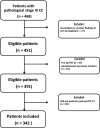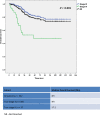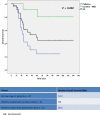Early PET-CT in patients with pathological stage III colon cancer may improve their outcome: Results from a large retrospective study
- PMID: 30350468
- PMCID: PMC6246942
- DOI: 10.1002/cam4.1818
Early PET-CT in patients with pathological stage III colon cancer may improve their outcome: Results from a large retrospective study
Abstract
Background: Current staging of pathological stage III colon cancer (CC) is suboptimal; many patients recur despite unremarkable preoperative staging. We previously reported that early postoperative PET-CT can alter the stage and management of up to 15% of patients with high-risk stage III CC. This study aimed to determine the role of the test in the general stage III CC population.
Methods: A retrospective study of all consecutive patients with stage III CC who underwent early postoperative PET-CT between 2005 and 2017.
Results: A total of 342 patients, 166 (48.5%) males, median age 66 years (range, 29-90), were included. Pathological stage was IIIA, IIIB, and IIIC in 18 (5.3%), 257 (75.1%), and 67 (19.6%) patients, respectively. Median number of positive lymph nodes was 2 (range, 0-32). PET-CT results modified the management of 46 patients (13.4%): 37 (10.8%) with overt metastatic disease and 9 (2.6%) with a second primary. The 5-year disease-free survival for true stage III patients was 81%. The median overall survival for the entire cohort and for true stage III patients was not reached and was 57.2 months for true stage IV. Of the 37 patients found to be metastatic, 14 (37.8%) underwent curative treatments and 9/14 (64.3%) remain disease-free, with a median follow-up of 83.8 months. Predictive factors for upstaging following PET-CT were identified.
Conclusion: Early postoperative PET-CT changed the staging and treatment of 13.4% of stage III CC patients and has the potential for early detection of curable metastatic disease. Outcome results are encouraging. Prospective validation is ongoing.
© 2018 The Authors. Cancer Medicine published by John Wiley & Sons Ltd.
Figures
References
-
- NCCN guidelines. https://www.nccn.org/professionals/physician_gls/pdf/colon.pdf.
-
- André T, Boni C, Mounedji‐Boudiaf L, et al. Oxaliplatin, fluorouracil, and leucovorin as adjuvant treatment for colon cancer. N Engl J Med. 2004;350(23):2343‐2351. - PubMed
-
- Chan K, Welch S, Walker‐Dilks C, et al. Evidence‐based guideline recommendations on the use of positron emission tomography imaging in colorectal cancer. Clin Oncol (R Coll Radiol). 2012;24(4):232‐249. - PubMed
-
- Mittal BR, Senthil R, Kashyap R, et al. 18F‐FDG PET‐CT in evaluation of postoperative colorectal cancer patients with rising CEA level. Nucl Med Commun. 2011;32(9):789‐793. - PubMed
MeSH terms
LinkOut - more resources
Full Text Sources




